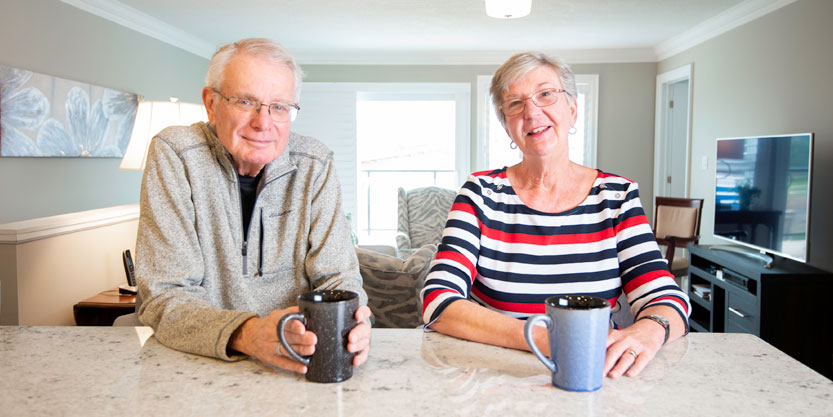TORONTO, ON – April 23, 2019 – Bruce & Jenn Mochrie made the move from Ancaster to their ZEST COMMUNITIES.
Bruce and Jan Mochrie were considering a costly renovation to the Ancaster house they had called home for 42 years when their son encouraged them to consider a retirement community.
They had never imagined living in a retirement community but began looking at options and agreed it was the perfect fit for this stage of their lives. “We had both recently retired and with our extra time, we enjoy travelling,” says Jan.
The pair recently returned from a cruise to the Panama Canal with friends they’ve made since moving into a three-bedroom garden home at The Village at St. Elizabeth Mills in Hamilton in 2017. The house was renovated from top to bottom before they took possession and features granite countertops and hardwood floors. “We got the renovation we always wanted,” says Bruce.
“We’ve met so many people with similar lifestyles who’ve become great friends,” he adds, rhyming off a long list of activities that includes cards, sports and gardening. “The other plus is that house prices have gone through the roof compared to what we paid 40 years ago, so we ended up with some money and a house that’s substantially better than the one we had before, except for the size of the property because we were on a third of an acre.”
Relocating to a retirement community is about much more than simply downsizing, says Tony Difruscio, president of Zest Communities, which is building the 55+ community at The Village St. Elizabeth Mills. It will soon begin construction of a five-storey building of one and two-bedroom units and is upgrading and doubling the size of a retirement residence that offers assisted living.
“What really brings people here is the lifestyle community and social interaction,” he says. “They have neighbours who look out for each other so they tend to stay independently living much longer. We have people in their late 90s here living independently here and very active.”
When considering a retirement home or community, look at your options and then narrow down your list based on preferences, advises Jim Huinink, editor of ComfortLife.ca. “These preferences are typically ruled by considerations related to location, price and then features of the community,” he says. “Some people want to live near their grown children, some people focus on the nest egg they have accumulated and how long it will last them, while other people may really be drawn in by that nearby community with an 18-hole golf course on site.”
Pay attention to the possibility of changing care needs. “If you get sick or if you lose mobility, is the community going to be able to take good care of you within your budget?” Huinink asks. “Ideally, you don’t want to ever move again because being moved around will only add to your stress in the future.
“That’s why we recommend that you consider communities with a full spectrum of care, from basic assistance right through long-term care and/or palliation. No one likes to think of those things but, really, you do your future self a service when you think ahead.”
When it comes to trends in retirement communities, personalization of care isn’t exactly new but still has room to grow, Huinink says. Retirement homes must adhere to laws and regulations but are leaning further away from the one-size-fits-all approach.
Inter-generational communities are another growing trend. On the west coast, for example, OPAL by Element is taking a “very progressive approach” to creating a community that’s focused on senior care but encourages a mix of generations, he notes. Lifemark Residences in Surrey is a house in a suburban location where seniors can live in an intimate environment but still have access to personal care. “It’s another interesting innovation, a little ahead of the curve, I think,” he says.
Finally, memory care continues to improve. “As we understand dementia better all the time, the care that we provide improves. People learn more about how to offer proper care to those troubled by dementia and this is put into practice in the best memory care homes,” says Huinink. “The design of communities for those with dementia is also being revolutionized.”



